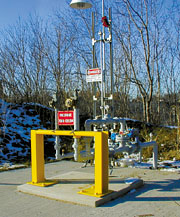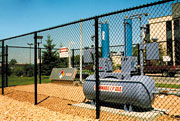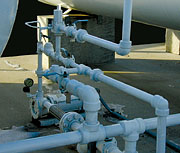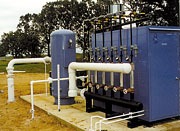

The Gas Balancing Act
Across the United States and Canada, weather is not the best friend of energy consumers. From winter heating spikes to huge seasonal swings in gas-fired electricity generation, natural gas consumption fluctuates dramatically.Unfortunately, the world's largest system of natural gas production, transportation, and storage operations cannot support 100% of peak demand in every location. Various load management schemes have long been used to balance seasonal peaks in gas demand with available pipeline deliveries. Some local gas distribution utilities supplement pipeline supplies using propane-air (LPG-Air) or liquefied natural gas (LNG) peak-shaving plants. Underground natural gas storage also helps keep gas flowing in some areas. And where gas meets the burnertip, utilities and/or third-party gas suppliers may simply reduce or completely curtail deliveries to larger institutional, commercial, and industrial consumers.
Many gas utilities offer reduced natural gas rates to large consumers in exchange for an agreement to go offline during periods of peak demand.
Generally, a "firm" commitment to supply gas is replaced by best efforts to supply under one or more "interruptible" options. Consumers can often save from 20% to 40% or more by choosing interruptible service. For this service to be viable, most consumers need an alternate fuel. The ideal solution would be a fuel that can be burned with no change in equipment and operations. That's where propane-air standby systems bring unique advantages to the equation.
Commercial propane is one of several liquefied petroleum gases (LPGs) derived from the processing of natural gas and crude oil. Stored as a liquid under pressure, propane (C3H8) vaporizes easily to produce a gas. As a gas, propane is heavier and has a higher energy density than methane (CH4), the primary component of natural gas. Consequently, some adjustment is almost always required to burn propane in equipment set up for natural gas. Using technology similar to utility peak-shaving plants, a consumer-owned, propane-air standby system avoids this requirement by blending propane with air to produce a mixed gas with burning characteristics similar to natural gas. This means gas energy keeps flowing when the natural gas supply is shut off - with no adjustments to combustion equipment.
Various grades of fuel oil are also commonly used as alternate fuels, especially in boilers. The basic problem many consumers face is that their gas fuel use may not be limited to boilers. Boilers can easily be equipped with oil/gas burners, but gas-fired rooftop ventilation equipment, process ovens, and a host of other equipment cannot. This is where propane-air systems shine. Propane-air provides an alternate fuel that is transparent to fuel-burning equipment. In fact, the switchover can even occur while the equipment is firing.
Even for boiler plants, propane-air systems have advantages over oil systems:
- Oil storage is subject to stringent requirements to avoid environmental damage due to leakage;
- Changeover from gas to oil in large boilers often involves changing the burner nozzle - a step that may require several hours for the boiler to cool before it can be performed; and
- Maintaining oil fuels is difficult; oil quality degrades over time.
Propane-air as an alternate fuel avoids these problems and preserves the low level of air emissions associated with natural gas combustion.

Propane-Air: How It Works
The main components of a typical propane-air standby system are a propane storage tank(s), fuel delivery station, pressurizing pump, vaporizer, and mixer. The output of the propane-air system is normally tied into a consumer's natural gas distribution piping after the utility's meter. Propane-air is distributed to fuel-burning equipment via the natural gas piping without any interruption of supply.Typical applications are:
- To provide a compatible "standby" fuel for consumers who are on interruptible gas service, or;
- For "peak shaving" where the consumer is either limited in the amount of gas available from the utility, or where the consumer purchases gas on a transport basis at a fixed rate per day or week.
In other words, propane-air can replace all or just a portion of a consumer's gas-energy needs.

Propane Properties
Propane vaporizes at -43.8°F at atmospheric pressure. In storage, its vapor pressure is about 23.5 psig at 0° and 175 psig at 100°. Therefore, propane systems must deal with propane both as a gas and a liquid. Undiluted propane vapor has a specific gravity of 1.52 compared to natural gas at .60 and air at 1.0.Propane gas will burn when combined with sufficient oxygen. The flammable range for propane is 2.0% to 9.6% gas in air. For comparison, the flammable range for natural gas is 4.5% to 16% gas in air. Expressed another way, the ideal combustion ratio for propane is 24:1 (96% air, 4% propane) while for natural gas, it's 10:1 (90% air, 10% gas).
Propane contains about 2,520 Btu/scf compared to natural gas with about 1,000 Btu/scf. Liquefied propane (at 60°) contains a little more than 92,000 Btu per gallon. Thus, 11 gallons of propane contains about 1 MMBtu (or 1 dekatherm) or about as much energy as 1 Mcf of natural gas. While natural gas is difficult to store at a consumer site, propane's energy density makes storage reasonably simple.

Identifying A Suitable Application
A potential propane-air application exists where both natural gas and propane are available. What kinds of energy consumers might benefit from a propane-air system? Typical small applications include schools, hospitals, nursing homes, warehouses, shopping malls, hotels/conference centers, etc. Larger applications include industrial users, food manufacturers, college campuses and electrical and/or steam-generating power plants.Propane system size and configuration depend on several factors:
- Size of the connected gas-consuming load, maximum/minimum flow rates, and maximum consumption per hour and per day;
- Pressure used for natural gas distribution;
- Special gas applications, if any, requiring methane exclusively, such as atmosphere generators or CNG;
- Expected changes in gas use (e.g., plant expansion);
- Insurance requirements (e.g., FM, IRI);
- Volume of propane storage needed, depending on:
- maximum consumption rate and "number of days" backup desired;
- requirements, if any, of natural gas utility, propane supplier, or other party;
- available space and code or insurance constraints;
- LP gas sources and delivery vehicle size. - Other uses for propane - such as forklifts or vehicle fleets - should be evaluated to determine propane supply requirements and system hardware.

Codes And Standards
NFPA 58, "Standard for the Storage and Handling of Liquefied Petroleum Gases" (recently renamed the LP-Gas Code) is a common minimum standard referenced in most state codes. Minimum distances are required between components of the propane system and from buildings and property lines. Good design practice should be observed, which may involve requirements exceeding the minimum requirements of this standard. Review of a proposed facility by state and local agencies is usually required. Insurers such as Factory Mutual and Industrial Risk Insurers also have specific requirements. Local code officials and fire departments should be consulted prior to construction and trained in the safety features of any system.
Propane-Air System Components
Propane storage tanks.Propane tanks are available for above- or below-ground installation. Underground or mounded storage is increasingly popular, enhancing both aesthetics and fire-safety. Under federal regulations and those in effect in most states, propane is not considered a ground contaminant (i.e., it is not a liquid at 60°). While double-wall structures are not required for below-grade installations, proper design, installation, and monitoring remain essential, including complete corrosion-protection systems.Tanks are available in many sizes. The most commonly used are 1,000, 2,000, 3,900, 12,000, 18,000, and 30,000-gal gross (water) capacity. Net fuel capacity is about 85%. Multiple tanks can be installed to achieve any desired total storage capacity. Typical tank trim includes required relief valves, excess-flow valves and gauges for temperature, pressure, and liquid level. Optional remote/automatic valve features are recommended for enhanced safety and control.
A site-specific fire safety analysis is required to determine appropriate features of the installed storage system.
Fuel delivery station. Most consumer standby systems receive propane via truck delivery. A truck unload station provides a convenient and safe connection for the propane supplier to deliver fuel to the tank. Station features include "breakaway" connections, fill and vent valves, excess flow valves, manual isolation valves, and emergency shutdown valves.
Propane pump. Because the pressure of propane in a storage tank varies with temperature, many propane-air systems utilize pumps to ensure adequate product pressure feeding the vaporizer. A wide variety of motor-driven pumps are available, including positive displacement and impeller types. For continuous duty, redundant pump systems are advised. Optional controls can be applied for autostart, etc. Pumping a liquid at its boiling point requires careful attention to pump placement and the design of related piping and controls. Effective vapor elimination is critical.
Propane vaporizer. Liquid propane is pumped to a vaporizer. This device heats the liquid to the boiling point to produce required volumes of propane vapor. The majority of vaporizers use a portion of the propane fuel for this task. Electricity, steam, and hot water heat input sources can also be used. Small- to medium-size standby systems often have vaporization equipment packaged with propane-air blending equipment.
Propane-air blenders (mixers). As a general rule, a propane-air mixture containing 1,400 Btu/cf has burning characteristics similar to natural gas containing 1,000 Btu/cf with a specific gravity of .60. A blender (also called mixer) is used for this purpose, producing mixed gas in volumes and at a pressure sufficient for distribution in a consumer's existing natural gas piping. There are several practical blender types and a wide range of control options.
Venturi blenders use pressurized propane vapor to entrain air through a specially designed nozzle. Atmospheric venturi systems are normally used for mixed-gas pressures up to 15 psig. Air-assisted venturi and carburetor systems (both requiring sources of compressed air) are in use for higher mixed-gas pressure ranges up to about 150 psig. Very large propane-air flows may be best managed using "parallel pipe" blenders to proportion compressed air and gas using digital control mechanisms. These blenders are in service at discharge pressures from less than 10 to 250 psig.
Critical considerations are accuracy of the device to produce a consistent propane-air mix across the full range of operation, capacity, reliability, serviceability, and safety of operation. On systems using compressed air, specific gravity or comparable mixed-gas monitoring equipment should be integrated in the control system. System operation should provide the consumer with seamless transitions to propane-air operation and back to natural gas.
Safety systems. Beyond minimum code requirements, LP gas safety can be enhanced in several areas at the typical site. Ultimately, local public safety agencies, insurance carriers, the propane system designer, and the owner must define safety systems and emergency response factors (e.g., fire protection) appropriate for a site.
Minimizing the potential volume and duration of accidental propane release is an important safety concern. While some protection against a system breech is required in basic construction (e.g., NFPA 58's requirements for excess flow valves), comprehensive Emergency Shutdown (ESD) systems offer improved containment. An ESD application normally includes actuated valves in all tank openings, fuel transfer connections, and at other locations. Remote and automatic closure of these valves can quickly seal the system. Interlocks to main system control, site power supply, offsite alarms, etc. can yield controlled, safe shutdown and improved emergency response.
Gas and fire detection systems. These can also be installed to monitor critical plant areas. Detection can be integrated within an ESD system for alarm and/or automatic shutdown of the plant.
System control. As with any process system, "control" of propane-air standby systems is a flexible concept. A well-designed system will include at least basic integration of the operating equipment and subsystems. Better still, integrated control of entire systems should be considered, ensuring that the process is made as safe, simple, and reliable as possible.
Even for smaller systems, advanced electronic process-control technology is easily applied. From smart transmitters to PLCs to computers, a well-executed control strategy can deliver improved accuracy and safety, automatic gas quality control, comprehensive monitoring, programmed start/stop routines, remote operation, and more.
Connection with natural gas measurement equipment can allow automated "balancing" of natural gas deliveries, avoiding potentially large penalties for using too much (or too little) gas. Integration with local or multi-site control networks is also possible.

Putting It All Together...
While many of the components described above can be designed, purchased, and installed separately, a systems approach has substantial benefits. Components are matched for capacity and can be preassembled at a manufacturing facility to ensure good quality control. The vaporizer and blender can be preassembled into a compact unit with appropriate controls and safety devices. Likewise, the fueling station and control panel(s) can be pre-engineered, prefabricated and shipped as completed units. Field assembly is simplified and overall quality improves.The end result is a system providing a higher level of energy security while saving money all year long. ES
